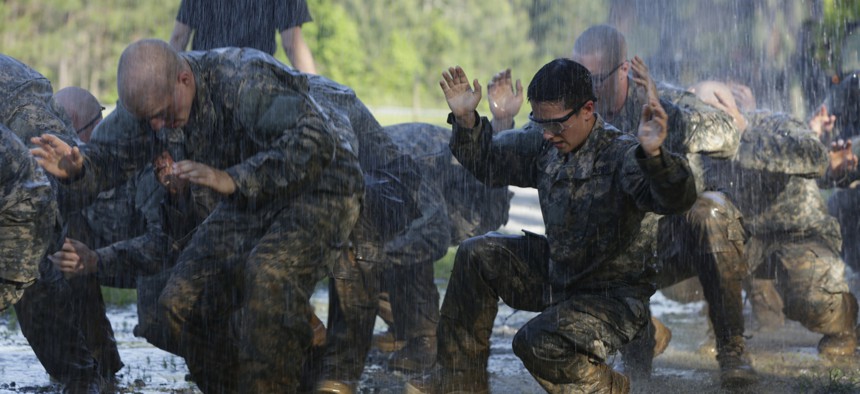
U.S. Army soldiers during the Ranger Course on Fort Benning, Ga., on April 21, 2015. Army/Sgt. Paul Sale
In Swamp Phase, Women Ranger Candidates Blend Right In
Everyone in the last phase of the Army's elite school looks the same: sweat-soaked and exhausted. And the Ranger Association says everyone who graduates can be a member.
EGLIN AIR FORCE BASE, Fla. — If they make it through Army Ranger School and earn the coveted Ranger tab, the three women soldiers – West Pointers all – now facing the Florida swamps and the Georgia mountains will become the first women ever to do so.
They also will be eligible to become the first women to join the U.S. Army Ranger Association. “If [any woman who graduates the School] chooses to apply for membership, her application will be accepted, processed, and granted in the same fashion as any other qualified Ranger,” the organization, which supports the Ranger community, said in a statement.
The 19 female soldiers who began Ranger School in April broke new ground as their presence created a coed class for the first time in the history of the storied school, known as the Army’s premier leadership course – and its most grueling. After the first week of physical tests, eight remained in the class, a success rate of 42 percent compared to 48 percent for male candidates. The first phase, Darby Phase, ended up claiming this shot at Ranger School for five of the eight. But three of the women, all of whom completed the Fort Benning phase of Ranger School three times, moved on to confront the mountains of Georgia for the second part of Ranger School. More than 100 days after their first morning in the course, two of the women have moved on to the heat-laden and reptile-heavy swamps of north Florida. What stands between them and earning the Ranger tab now is ten days of tests: crossing swamps, building rope bridges, leading and following fellow Ranger School candidates on ambushes and raids.
Down in Florida this week, the sun beat down on the obviously exhausted Ranger School candidates as they practiced waterborne techniques: learning to build rope bridges, crossing the swamp, and boarding Zodiacs to travel down the Yellow River in groups of eight or nine. Soldiers emerging from a rope bridge exercise knelt and pulled security beneath a shady passage of trees while water gushed from their uniforms onto the previously dry land below.
And while the media cluster of TV, online and print outlets had clearly come to see the women, reporters frequently found themselves unable to pick them out. Every one of the Ranger School candidates sported short hair cropped close and the same uniform. Many wore sunglasses behind which their sweat dripped in the Florida sun. And most notably, they all looked wiped out, chewing Trident and sugary bubble gum to stay awake during classroom training sessions and occasionally standing up to keep sleep at bay. Timothy Spayd, a retired Ranger now in his fifties, kept up a cheerful presence amid the exhaustion, offering a tap on the arm or leg to the Rangers School students in danger of dozing off during training sessions. The only quick giveaway of the differences among the students was the female voices that could on occasion be heard as they planned their next moves.
For Col. David Fivecoat, who has helped launch this first-ever integrated Ranger School Course, the idea of bringing the media was to show, firsthand, that no standards had been changed and no exceptions made just because women now had a shot at trying for the tab.
“All the women did the exact same thing as their male counterparts,” Fivecoat said. “We set out with one standard and everyone meets that standard and there is some goodness in that.”




